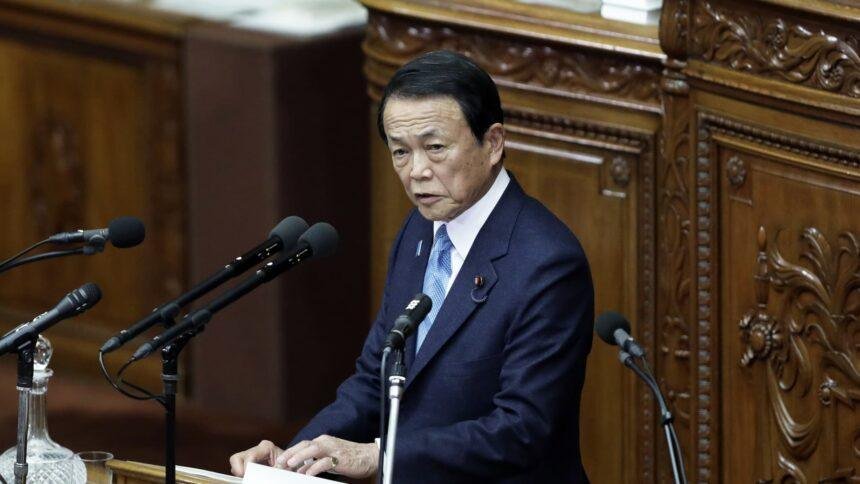Takaichi’s Leadership: A New Era for Japan’s Fiscal Policy?
In a significant political development, Sanae Takaichi, poised to become Japan’s first female prime minister, has appointed former Prime Minister Taro Aso as vice president of the ruling Liberal Democratic Party (LDP). This decision, made on Tuesday, has sparked discussions among analysts regarding its implications for Japan’s fiscal policy, particularly in light of the country’s mounting debt and economic challenges.
A Strategic Appointment
Takaichi’s selection of Aso, a seasoned political figure known for his fiscal conservatism, is seen as a strategic move to balance her more aggressive fiscal stance. Aso, who previously served as finance minister during the implementation of Shinzo Abe’s “Abenomics,” has long advocated for maintaining fiscal discipline in a country burdened by significant debt. His presence in Takaichi’s administration may serve as a moderating influence against potential overspending.
In addition to Aso, Takaichi has appointed Shunichi Suzuki, another former finance minister, as the LDP’s secretary-general. This role is crucial in shaping party policies and strategies, further solidifying Takaichi’s leadership team with experienced figures who have a history of navigating Japan’s complex economic landscape.
Market Reactions and Economic Implications
The announcement of Takaichi’s leadership team has already had a noticeable impact on Japan’s financial markets. Following the news, share prices surged while the yen weakened, reflecting investor optimism that Takaichi may pursue substantial fiscal stimulus. Analysts suggest that her administration could prioritize economic growth, potentially at the expense of fiscal prudence.
Takahide Kiuchi, an executive economist at Nomura Research Institute, noted that Aso’s backing during the leadership race indicates that Takaichi’s policies may still be influenced by his more cautious approach. “Aso’s influence could moderate aggressive fiscal or overly dovish monetary impulses,” Kiuchi stated, highlighting the delicate balance Takaichi must maintain between stimulating the economy and managing Japan’s fiscal health.
Historical Context: Aso’s Legacy
Taro Aso’s political career has been marked by significant events that have shaped Japan’s economic policies. He was at the helm during the 2008 financial crisis, which had far-reaching effects on the global economy. His experience during this tumultuous period has informed his views on fiscal responsibility, making him a key figure in discussions about Japan’s economic future.
Aso’s tenure as finance minister coincided with the launch of “Abenomics,” a series of economic policies aimed at revitalizing Japan’s stagnant economy. While these policies initially spurred growth, they also contributed to the country’s already high debt levels. Aso’s advocacy for fiscal discipline stands in contrast to Takaichi’s more expansive spending proposals, creating a potential tension within the new administration.
Bond Market Concerns
Despite the initial market enthusiasm, bond investors are expressing concerns about the sustainability of Takaichi’s proposed fiscal policies. The yield on the 20-year Japanese government bond recently reached a 26-year high, while the benchmark 10-year yield hit a 17-year peak. These increases reflect apprehension about the potential for rising government spending to exacerbate Japan’s fiscal challenges.
Analysts are particularly wary of Takaichi’s potential coalition with the opposition Democratic Party for the People, which has advocated for tax reforms aimed at increasing disposable income for households. Naomi Muguruma, chief bond strategist at Mitsubishi UFJ Morgan Stanley Securities, warned that such an alliance could lead to increased spending, further straining Japan’s finances. “If Takaichi were to choose the Democratic Party, the size of spending could rise depending on what its leader will demand in exchange for forming an alliance,” she explained.
The Path Ahead
As Takaichi prepares to assume leadership, the balance between fiscal stimulus and discipline will be a critical focus. Her administration’s ability to navigate these competing priorities will not only impact Japan’s economic trajectory but also influence investor confidence in the country’s financial stability.
The challenges ahead are significant. Japan’s economy has been grappling with stagnation for decades, and the COVID-19 pandemic has only exacerbated existing issues. With a rapidly aging population and declining birth rates, the need for sustainable economic policies has never been more pressing.
Conclusion
Sanae Takaichi’s ascension to the role of prime minister, coupled with Taro Aso’s appointment as vice president of the LDP, marks a pivotal moment in Japan’s political landscape. As the new administration prepares to tackle the country’s economic challenges, the interplay between aggressive fiscal policies and the need for fiscal responsibility will be closely scrutinized. The coming months will reveal whether Takaichi can effectively balance these demands while steering Japan toward a more prosperous future.











